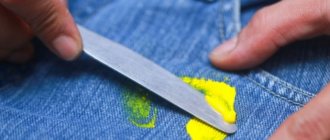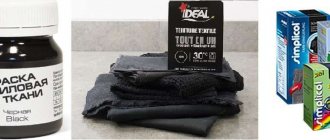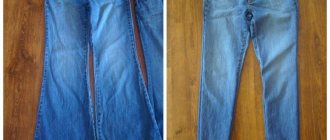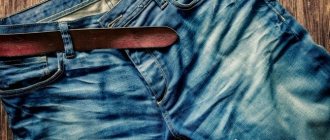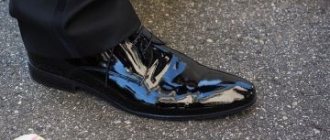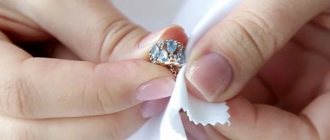Image Slide 2
Image Slide 1
Image Slide 3
black-clothes-
black-clothes-ours
Black items are versatile, suitable for everyday wear, special occasions, parties and formal meetings. Over time, any shade fades from washing and fades in the sun. To prevent this, there are many methods, both home and professional. Unlike white, black color is more capricious, so you should take care of such clothes correctly. In this article you will learn how to return a rich color to a black item without using chemicals, and the secrets of caring for dark items.
Causes of color loss
After washing, any items lose their color saturation. Denim products are no exception. Despite the fact that this is a dense material and lasts quite a long time, over time during wear it loses its attractive appearance. Such clothes become faded, which is why they appear worn out and old. This type of favorite item is upsetting, because not everyone knows how to restore the color to jeans themselves at home.
The composition of detergents, as well as water, lead to loss of rich color. They wash the dye out of the fibers of the material. After several washes, the item looks several shades lighter. Denim items often fade after washing, which is also another reason for discoloration. This can be seen by the color of the water as it takes on the color of the clothing.
Most of us think that denim fades due to the poor quality of the dye used during the production process. In fact, even natural paint compositions used by well-known companies release coloring pigment in the first few washes. After purchasing, you should conduct a test to understand how much the item can shed. To do this, take a cotton pad and lightly rub it over the fabric. If the product is of high quality, then it remains clean.
Active sun rays cause damage, because clothes fade in the sun. A light shade appears on jeans if they are actively worn.
Why do black things lose their hue?
Why do black things lose their shade?
Dark clothes are necessarily treated with dyes, which wash off over time. Cheap things lose color very quickly, unlike expensive and high-quality ones, but even with them a similar problem happens. During washing, the product experiences mechanical and chemical stress, which has a bad effect on the color. Scuffs and damage on black items are very noticeable. In addition, housewives are faced with white stains after improper washing. Also, a black thing can suffer from:
- Burning out the color with an overheated iron.
- Sunburn.
- Long-term storage in a closet.
- Washing in very hot water, which causes the item to become deformed and fade.
If your black clothes are shedding and you don’t know what to do, first familiarize yourself with the secrets of proper washing. Simple recommendations will help avoid color loss and maintain the presentable appearance of the product for a long time:
- Before washing and ironing, you must read the information provided on the label;
- Wash colored items separately from dark ones, using special products intended exclusively for them;
- Do not dry black and colored items in the sun next to each other;
- Things are rinsed well. If you wash in an automatic machine, use an extra rinse.
- When washing, do not use powders and gels with bleach;
- Rinse knitted items by hand in cold water;
- Turn clothes inside out before washing;
- Use the delicate mode on automatic machines.
To ensure that items made from delicate fabrics retain their color longer, wash them by hand. Often machines have a “hand wash” mode, which is perfect for such clothes. As a preventive measure, after each wash, black items are rinsed in water with vinegar and salt. Drying should be done in places where there is no direct sun. Before loading items into the machine, wait until the detergent dissolves, otherwise stains or streaks may remain.
What do you do with faded items?
Note! If a stain appears on a black item, do not use bleach or stain removers. In such situations, enzyme powders that fight contaminants in cool and warm water will help.
How to restore color to jeans at home
There are many ways to restore the color saturation of your favorite things. But before the process itself, you should properly prepare your clothes.
Wash and dry your jeans before restoring. Pay special attention to contaminated areas.
If you do not prepare the item, paint or other products may not adhere well, resulting in dullness.
It is also important to decide which recovery method you will use. The color can be restored by hand washing or using a washing machine. After that, we move directly to the process.
Special dyes
To correctly and reliably restore the color of a product, store-bought dyes are used. These are usually substances with a chemical composition for cotton fibers. Using this method, you can highlight the advantages:
- do not cause allergic reactions;
- effective and quick results;
- simple and convenient.
There are also disadvantages - the tissue quickly deteriorates after the procedure. But if you use this method extremely rarely, you don’t have to worry about it.
The dyeing technology is as follows:
- How to restore color to jeans that have lost their rich black tint at home
- Take a container that is heat resistant. Pour 10-15 liters of water. Pour in the coloring powder or concentrate previously dissolved according to the instructions.
- Place the container on the stove and put the jeans inside.
- We are waiting for it to boil. Sometimes we turn things over. This will help the jeans dye evenly.
- After 20 minutes, add a little salt. Cook for another 10 minutes.
- After the procedure, wash the jeans in warm water, then in cold water.
- Dry well.
The most effective dyes for clothes: Dr. Beckmann, Ideal Black Jeans, IDEAL MINI, Rit Dye Black.
Potassium permangantsovka
Many people wonder what to do if black jeans have lost their color.
Use potassium permanganate. Quite a simple but effective way:
- Take a deep container, preferably enameled.
- Mix water with potassium permanganate. We wet the jeans and immerse them in a container.
- We wait some time for the item to be painted over.
- For better effect, add a little salt.
- After the process, rinse the jeans with cold water.
- To consolidate the result, add vinegar. After rinsing, straighten the product and let it dry on a flat surface. You can put a towel underneath.
Wet products appear slightly darker than dry ones. Keep this in mind before removing your jeans from the container.
Hair dye
Ordinary hair dye will help give a new look to old jeans. To carry out the procedure, you need to stock up on the following items:
- a large basin;
- black paint - two or three bags will be enough;
- three percent table vinegar;
- salt;
- gloves to avoid getting your hands dirty.
To get three percent vinegar, take one glass of nine percent vinegar and dilute it with two glasses of plain water.
We perform the following actions:
- Don't forget to wear gloves.
- Mix the paint as indicated in the instructions.
- Mix the resulting slurry with water.
- We soak the jeans. We're waiting for an hour. To ensure uniform dyeing, you should turn the clothes over after a while.
- After an hour, take it out and rinse with cool water.
- Take cold water, add vinegar and salt. Soak again.
- After all, we wring out the jeans and dry them.
Washing Fading Clothes
There is an unusual way to restore the color of black jeans without harming them. This is machine washing with faded clothes. Take black clothes that have not yet lost their color. Then follow the instructions:
- We take two things and turn them inside out.
- Put it in the washing machine.
- We set the mode to forty degrees.
- Turn off the machine after thirty or forty minutes. Leave the clothes for 2-3 hours. This will enhance efficiency.
- Afterwards we finish the washing cycle in the machine.
- While rinsing, add 1 tbsp. vinegar and conditioner.
After completing the cycle, hang the products on the dryer.
Do not hang it on the balcony. Direct exposure to sunlight will cause your jeans to become dull again.
Restoring the black color of jeans
As practice shows, it is not so easy to return black jeans to their former beautiful and rich color. However, using folk remedies, you can try to do this even at home. Ways to return color to black jeans:
- Using cigarette tobacco. To do this, pour boiling water over a tablespoon of tobacco and leave for the solution to infuse. Wipe clean jeans with a sponge soaked in solution. Upon completion of the procedure, the tobacco product is not washed off, but dried.
- Rinse jeans in a solution of water and vinegar (a tablespoon of 9% vinegar per liter of water). You can also leave the jeans in the solution for half an hour, and then rinse under cold water and dry.
- Wash jeans with other black clothes. It will be good if these products are heavily colored. You can improve the effect if you pause the wash and leave the washing machine for half an hour, then finish the wash. After this, you can rinse the jeans in a weak vinegar solution.
How to resurrect old jeans. How to update an old denim item
You can change your favorite denim without altering it. The clothes will remain comfortable, but a few creative details will emphasize individuality and add completeness to a fashionable look.
Pieces of denim can be recut and re-glued like paper. You can also paint it, tear it in the right places, mix it with another fabric, or assemble a new thing from stripes and shapeless shreds.
Since the advent of stitching (for a moment, 1873!) Levi Strauss's indigo-colored work denim clothing has been occasionally used in everyday life. After World War II, young people began to pay attention to denim clothing, and at the end of the 20th and beginning of the 21st centuries, the talented hands of designers turned sometimes rough fabric into a rare work of textile art.
How to freshen up a denim item
Combination of denim and:
- python skin;
- fur;
- rhinestones;
- Silk embroidery adds a touch of luxury. Suitable for lovers of the Boho style.
Denim clothing decorated with chains and spikes will appeal not only to rockers. A few metal details on skinny girls' jeans will emphasize their fragility.
Holes, abrasions, and multi-colored stains on denim clothing become an accent in urban clothing. And the combination of traditional cross-stitch and rigid fabric will appeal to adherents of the “ethno” and “country” styles.
Embroidery
Embroidery looks good on denim. The embroidery machine will need stabilizing fabric and special threads. Ordinary sewing shops do not embroider (unless the owner knows how to stitch with the machine running freely), but manufacturers offer decorative and finishing stitches to choose from. If you stitch with colored thread and a double or triple needle, you will get an interesting design.
Weave denim threads are not suitable for warp. Therefore, for embroidery, a canvas is used, which is placed on top. At the end of the work, the threads are pulled out or carefully cut, closing the ends, for example, with a chain stitch.
Water-soluble canvas is sold in narrow strips. If the embroidery covers a small area, one leaf is enough.
Embroidery with beads, pallets and beads revives even an old thing. There is a wide range of different colors and shapes on sale. Beads are usually sewn onto fabric using a backstitch; the beads can be strung on a thread and sewn in a zigzag pattern on a sewing machine using a bead foot.
Advice. Use grandma's jewelry. Often these products contain high quality beads and beads.
Applique, stripes
The assortment in sewing supply stores allows you to choose from funny “cartoon” designs to military-themed patches. Usually this is an embroidered piece of fabric without an adhesive surface.
In this case, it is basted and then sewn on by hand or on a sewing machine.
You can use any fabric for decoration. It is glued to the thermo-adhesive non-woven fabric with an iron, cut out and glued to the denim, having previously removed the protective layer. In this case, there is no need to sew the applique along the edge.
By the way. The more stripes that partially overlap one another, the more interesting it is.
Rhinestones
Rhinestones are a simple option for decorating jeans. For gluing you will need tweezers, an iron and adhesive tape (painting tape will do). Technical tape is not used due to its strong adhesive base.
- Clean and ironed clothes are laid out on a flat surface. Using chalk and washing-up soap, apply the outline of the design. Then the rhinestones are laid out.
Attention . A colored fabric marker (or pencil) usually disappears after washing (or a few days after application). If you plan to “walk” the new thing right away, they don’t use such tools.
- The backing (matte part) of the thermal adhesive tape is removed, and the lined rhinestones are covered with the transparent sticky part. Correct the displaced “glasses” using tweezers.
- The film with rhinestones from below is covered with a matte part, making a “sandwich”, where the rhinestones are located between pieces of adhesive tape.
- The structure is heated at a low altitude with a heated iron (turn off the steam!), without touching the surface.
- The backing is separated, the film with rhinestones is placed on the fabric and pressed well.
Advice. Use a book wrapped in 2 layers of pillowcase.
- Iron the clothes from the wrong side for 30-40 seconds. (“cotton” mode), pressing the iron firmly.
- Carefully remove the adhesive tape.
Items decorated with rhinestones can be washed in cold water (30 g) with a slight spin.
Spikes
Metal blocks, silver and yellow thorns (less often colored) are attached to the fabric using the same method as rhinestones, using an iron.
If, according to the model, the spikes are attached to the sleeves (without cuffs) or trouser legs, to make the edges rigid, they are folded, stitched with a “blind” seam or on a sewing machine: a foot for hemming the bottom of trousers is well suited for this.
Clue
If you need to boil your jeans to a more or less uniform white color, you don’t need to twist them into a rope, just put them in boiling water with bleach. Monitor the cooking process very carefully, regularly turning the jeans in the pan with a wooden stick so that the water and bleach can flow into each fold.
Finally, the transition points between a darker shade and a lighter one can be rubbed with a stiff clothes brush to give the item an even more stylish, worn look.
If a yellow bleach stain has formed on your white jeans, you can also try to remove it by treating it with one of the following products:
- ordinary household stain remover;
- hydrogen peroxide;
- powdered acetylsalicylic acid tablets (pharmaceutical Aspirin), diluted to a thick paste with water;
- paste of baking soda and water.
After applying any of the above products to the damaged area, the item should be allowed to sit with it for 20-30 minutes. Then rinse and wash as usual. If necessary, repeat the procedure.
How to update old jeans. 5 Easy Ways to Refresh Old Jeans
To make old jeans fashionable, you need to age them even more. It's easy to do it yourself in a few minutes.
Fashionable distressed jeans cost a lot of money. But why overpay if you can update your favorite pair in such a way that all fashionistas will turn their heads? There are simple ways to do this.
Jeans with holes
It seems that making holes in jeans is not difficult, but there is an algorithm here. You will need:
- Scissors
- Chalk
- Cardboard
- Needle
Decide where you want to make holes. They shouldn't be too tight.
Keep in mind that holes tend to grow.
Place a piece of cardboard under your trouser leg and use chalk to mark the place where the hole will be. Make an incision in this place slightly smaller than the desired hole, and use a needle to remove all the transverse threads. It is better to make small cuts, gradually widening them.
Faded jeans
These are not holes yet, but just small abrasions, which can even be used for office clothes. It's up to you to decide: it will be a small scuff near the pocket, or along the length of all the jeans. Keep in mind that on the knees and other tight-fitting places, abrasions will quickly increase and become holes.
You will need:
- Pumice or sandpaper
- Cardboard
- Chalk
- Gypsy needle
Using a chalk, determine the place where the wear will be and place a cardboard under the leg of the pants so as not to rub the jeans on the other side.
Gently rub with a pumice stone or sandpaper against the stitching until the desired size of abrasion appears. Use a gypsy needle to remove the transverse threads.
Jeans with fringes
Fringe at the bottom of the leg is a super trend this season. These jeans are easy and simple to make yourself.
- You will need:
- Paper tape or chalk with a ruler
- Scissors
- Tweezers
Using paper tape or a ruler, mark the boundaries where the fringe will end. It’s good if it exposes the bone on the ankle. Please note that after washing the fringe will jump up a little.
Cut the jeans and use tweezers to pull out the white threads. If your jeans are tight, avoid puffs. Once you have the fringe of the desired size, wash your jeans and comb it.
See details
Ragged hem jeans
This is another trend that will be relevant throughout the spring and summer of 2018.
You will need:
- Pen
- Ruler
- Scissors
- Gypsy needle
Use a pen to mark where the legs will end at the front and back. Draw the outline under the ruler and cut with scissors.
Jeans with studs
This method requires a special rivet gun, or at least pliers, but it can be used everywhere: spikes and rivets are at the height of fashion and they can be used to decorate not only jeans. This season it is possible to create some geometric shapes from rivets.
You will need:
- Pen
- Rivets
- Rivet gun or pliers
Use dots to draw the design you want to make on your jeans and execute it using a special gun.
Ready!
Lock color
Fixing the resulting shade after dyeing denim at home is a mandatory procedure. It's very simple.
Pour five to six liters of slightly heated water into a large container (enamel or plastic). Stir rock salt or “Extra” into it at the rate of: a large spoon for each liter of liquid. It is important to ensure that the crystals disintegrate. Otherwise, it is possible that a whitish coating may form on the material.
Turn the product inside out and soak in a saline solution for about half an hour. No longer, unless you want to end up with a frayed item in the future. Take the jeans out and let them drain without squeezing.
Fact! The water will become colored after soaking. But this is the norm - excess dye simply comes out of the fabric.
The next step is regular hand washing with the addition of liquid washing powder. Additionally, you need to pour two tablespoons of salt into the bowl. You just need to gently “squeeze” the jeans without rubbing or twisting the fabric.
Rinse denim thoroughly. And prepare an aqueous solution of 9% vinegar for the last rinse: two large spoons per liter of lukewarm water. Soak the jeans for two to three minutes, take them out, squeeze them lightly and hang them straight to dry.
The vinegar will help set the color and prevent it from fading.
From the green grass
- Pour 70-90 degree alcohol (instead, you can use 9% clear vinegar, hydrogen peroxide, vodka) for half an hour. Then wash the item as usual.
- Cover with baking soda for 1-2 hours and moisten, then wash thoroughly.
- You can mix ammonia with hydrogen peroxide (1:1). This mixture will help to effectively clean off old green grass stains that have already ingrained into the fabric. But here you need to act very carefully: make sure that the jeans do not discolor. It is better to test the product first, for example, on the back of the waistband of jeans.
How to make old jeans bigger. How to increase the waistband on jeans (master class)
Many denim trousers become small after washing in hot water. How to widen jeans waistband? You can, of course, do this using an iron and steam or stretching wet jeans on yourself. But all these methods are appropriate only before the first wash.
After each wash, you will have to do this stretching every time - you will be tired of stretching. We propose to solve this problem - to embroider the belt by 3-4 cm. We will need a piece of fabric similar to the fabric of jeans. It is better to take fabric with stretch. You can use leather or suede.
To work you will need:
- Jeans.
- Scissors.
- Threads match the color of those used for stitching on jeans.
- A sheet of paper, a felt-tip pen.
- Tailor's pins.
- Centimeter.
- Ruler.
- A piece of fabric or leather.
- Thin piece of soap - draw a pattern.
So, we increase the jeans according to our size. We measure our waist and the waistband of our jeans. We determine how many centimeters of fabric need to be added for comfort. If your denim trousers have a loop above the side seam, you need to undo it.
We make a cut above the side seam with scissors. You can hem the side seam and cut only the waistband. It all depends on how much you need to enlarge and embroider skinny jeans. Next, fold a sheet of paper, place it under the belt and trace the wedge with a felt-tip pen.
The result is a paper wedge pattern. Place a piece of fabric and trace the pattern with soap. We take a ruler and, stepping back 1 cm from the intended line, use a ruler and soap to trace the pattern again.
Then use an iron to press the hem inward, like this.
We combine the sections of the belt and the wedge, bent by 1 cm. We pin it with pins.
Next, we bend the second half of the wedge down and pin it with pins. We sew by machine or, in the absence of a sewing machine, we sew by hand.
If there is a loop left, sew it above the side seam. That's all. We hope you find our master class “How to widen your jeans at the waist and hips” useful.
This is what the finished jeans look like. If you put a strap on top of the belt, the wedge will not be noticeable.
How to increase a jeans size? Try sewing a small insert made of leather or suede; soft eco-leather will also work. This is what the leather insert looks like. As you can see, everything looks very neat. First steam the belt loop and sew it on again at the end of the work.
Painting with acrylic paints
Retail chains today offer a wide range of dyes for clothing. Acrylic paints allow you to add any color and various shades to almost all fabrics. This type of dye has the ability to completely dissolve in water, due to which the fabric is dyed as evenly as possible. Moreover, the dried item is not afraid of any washing - the selected color remains unchanged. To secure the final result, it is recommended to iron the jeans from the wrong side, placing paper under them.
These dyes are recognized as the most effective. They dry quickly, lie flat and remain saturated for a long time.
"Ambulance"
Just to start with your favorite item, you need to provide “first aid”: stop the process of destroying the fabric by the bleach that gets on it. The stain must be thoroughly washed with cold running water. Just do not rub or wash it under any circumstances! Then treat with one of the substances:
- an aqueous solution of sodium thiosulfate (1 teaspoon per 1 glass of water); the drug is sold in pharmacies;
- baking soda mixed into a thick paste in cold water.
The product should be applied to the damaged area from the front and back. After 10 minutes, rinse thoroughly again under the tap. This will help remove any remaining chlorine from the fibers.
From rust
Rust stains can appear not only because the owner of the jeans gets into it somewhere. Over time, rust can form on the fabric around metal rivets or buttons. The reason for this is numerous washes. In these places it is not very noticeable, but the very fact of the presence of stains is unpleasant. To remove rust, it must be dissolved in acid. For example, in lemon (3-4 grains per 1 tablespoon of water) or in natural freshly squeezed lemon juice. You can use an aqueous solution of 7-9% clear table vinegar.
One of the products should be applied to the fabric, wet it thoroughly, then iron the area with a hot iron through a gauze cloth, first from the front side, then from the back. After this, wash the jeans by hand with soap and warm water.
How do you like the article?
From fuel oil, machine oil
The following products will help you deal effectively with these stains.
- Toothpaste. It should be applied to the stain and left until it dries completely. Then wash it. You need to be careful not to use toothpastes with a whitening effect - these can discolor the denim.
- Chalk. It needs to be crushed into powder and poured thickly onto the area of contamination. Leave overnight. By morning the stain should disappear forever.
- Dishwashing gel . It perfectly dissolves fat-containing substances. The gel does not need to be diluted in water the day before application. After 15 minutes, the jeans can be rinsed from the gel and washed in the machine as usual.
- Gasoline and kerosene. Apply one of these products to a cotton swab and rub the stain with it. Just be careful not to press too hard to avoid damaging the fabric structure. Wash as usual.
How to dye blue jeans
Let's move straight to the description of the means with which you can restore the rich blue color of your jeans.
The classic denim color indigo has many shades and has not lost its popularity over the years.
Traditional denim dye used to be made from the Indian indigo plant, from which it gets its name. Its color is characterized as intermediate between dark blue and violet. To dye jeans at home and provide them with an even and lasting blue color, use ready-made textile paints and available products.
Blue
Blue in the form of a solution or powder is one of the most affordable and easy-to-use dyes.
The blue contains the organic dye “methylene blue” and starch.
Dyeing jeans blue is quite simple - you don't even have to boil them. It is enough to make a saturated concentrated solution using cool water (about 30 ℃) with the addition of 1-2 tbsp. l. salt for color fastness, and immerse things in it. It is recommended to soak jeans for 1.5-2 hours or even the whole night, and it is important to ensure that the fabric is completely immersed in water. After soaking, the jeans are placed in a cold vinegar solution for 10-15 minutes.
Drying painted items is necessary in a straightened form; it is best to lay them out on a horizontal surface. Otherwise, water flowing down the folds will wash away the color, making it uneven.
A serious disadvantage of blue dyeing is that the color fades quite quickly with subsequent washes, and the procedure will need to be repeated regularly.
Dylon
Dylon is one of the new household chemicals designed for both washing and tinting denim. The product is convenient, economical and quickly gaining popularity among fans of classic denim.
Packaging of DYLON powder dye (1 pc. per material weighing 500 g)
Aniline dyes for fabric
The use of aniline dyes for blue jeans has some peculiarities.
If you want to dye your jeans, keep in mind that all the decorative thread stitching (traditional yellow-orange shades) will also dye and become the same color as the fabric
When using aniline dyes, table salt must be added for color fastness. Details of the technology and the required proportions must be indicated by the manufacturer on the packaging. Typically, a bag of powder paint is designed for 7-10 liters of water. It is first diluted in a small volume, achieving complete dissolution, and then poured into the full volume of water. Add salt (100 g) there and mix thoroughly. Things to be dyed are immersed in a container in a straightened form and make sure that they are completely covered with the solution.
Ready-made paints in liquid forms wash out faster and are more suitable for refreshing the base tone. To properly dye jeans or completely change their original color, it is advisable to choose paints in the form of powder formulations.
Don't be afraid to experiment and give new life to your favorite things!
Additional recommendations
If the material contains decorative elements (rhinestones, etc.), it is preferable to wash the product by hand or place the pants in a separate bag before putting them in the machine drum.
In the latter case, the most gentle operating mode should be installed.
Cleaning black jeans with chemicals is prohibited. Due to aggressive influence, the product not only loses color, but also quickly wears out. It is also recommended to wash jeans with black items that have begun to fade. In this case, the white stripes may disappear, and the original color of the product will be fixed.
How to dry properly
Black jeans should not be wrung out after washing. To remove excess moisture, the product must be blotted with a towel. When drying your pants, you should follow several recommendations:
- hang it so that the trouser legs remain straight;
- Avoid exposing your trouser legs to direct sunlight;
- hang the product away from heat sources;
- To speed up drying, hang jeans in ventilated areas or in the open air.
The product should be dried by turning it inside out. You should not wear wet jeans, as dirt and dust will quickly settle on the fabric.



